
Go to: Precision Ballistics and Records Software ( Home )
Click here to bookmark this site.
Estimating the Ballistic Coefficient of Jacketed and Cast bullets
The best method of determining the ballistic coefficient of any projectile is to physically measure the amount of velocity reduction over a carefully measured distance. Since that is not always possible, some means other than an educated guess is needed to estimate a reasonably accurate ballistics and trajectory package.
The Ballistic Coefficient of tangential ogive jacketed bullets traveling at velocities above the speed of sound can be calculated to a reasonable degree of accuracy if careful measurements are made to determine the actual radius curve of the nose portion and the boat tail (if any) dimensions.
Most ballistic calculators require that the bullet be laid upon a chart of different profiles(such as the Coxe-Bugless Chart) in order to find a curve that most closely matches the curve of the ogive of the bullet. However this method is not nearly as accurate as a precision measurement.
Close measurement of the distance from the start of the tangential ogival curve to the foremost part of the nose, along with a measurement of the diameter of the tip and the diameter of the bullet can, by a mathematical formula, provide an exact value for the radius of the curve of the bullet ogive. This value, divided by the diameter of the bullet returns the "Caliber of the Ogive". From this value, the "Coefficient of Form" or "form factor" of the bullet may be calculated. Applying a formula containing the measurements of the boat-tail reduces the form factor in proportion to those measurements. After the form factor is determined, it is divided into the weight of the bullet (in pounds) and the resulting value is divided by the square of the diameter of the bullet, thus calculating the ballistic coefficient of that bullet for the G1 Drag table.
Possibly the most difficult part of the procedures is that of measuring the length of the nose, as it is quite hard to determine exactly where the main body ends and the curve of the radius starts. One method that works well is to set and lock a caliper tool to 0.001" less than the diameter of the body of the bullet, then slide the calipers up the bullet nose, toward the bullet body, until the movement is stopped, then carefully mark that spot. It will be very close to the point where the bullet body ends and becomes the start of the bullet nose.
The images shown below will show the details of the critical measurements required to estimate the Ballistic coefficient of different types and styles of jacketed bullets.
The method for determining the ballistic coefficient for cast bullets is essentially the same as for jacketed bullets with two exceptions. The first is that cast bullets generally have a bore riding nose portion that is of a smaller diameter than the body of the main bullet and the second exception is that the overall length of the bullet is a factor in the calculations. These measurements must also be made and the results entered into the appropriate space in the calculator.
When a cast bullet with a radius curved ogive ending in a round nose is encountered, as shown in the images below, measure the distance from the base of the nose radius, where it joins the bore-riding section or front driving band to the start of the nose tip, as illustrated below, and enter that value as Nose Length.
Note that the tip usually resembles a hemisphere or round ball before the curve changes to a radius curve as the illustration shows. Measure the diameter of this hemisphere where it joins the radius curve, as shown, and enter this value as the Tip Diameter.
Estimation of the ballistic coefficient of cast bullets is nearly as accurate as with the jacketed bullets, and the calculations give reasonably good and comparative estimates of G1 ballistic coefficients.
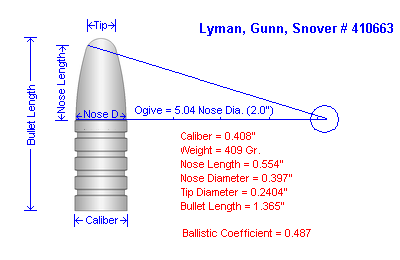
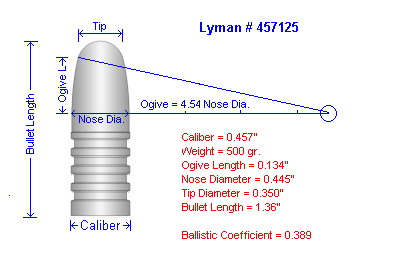
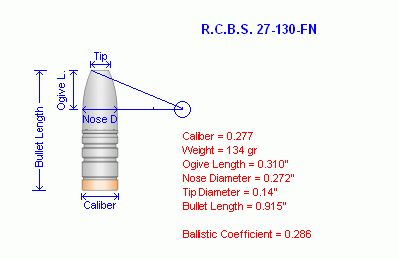
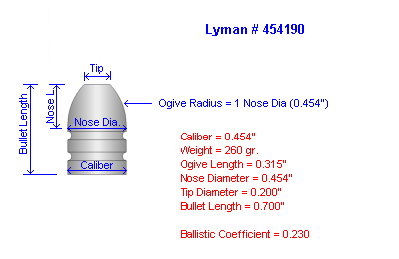
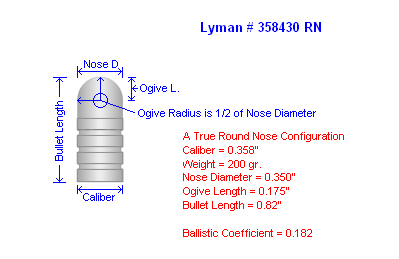
Go to the EstimatorSelect the type and style of the bullet with the radio buttons and then Carefully measure and enter the values required in the appropriate windows.
Using the "Tab" key on your keyboard will jump the focus to the appropriate window entries for the type and style of bullet you have selected.
If another Ballistic Coefficient for a different type or style of bullet is to be calculated, be sure to click on the "Reset" button.
Most browsers will support the print function, enabling you to print a hard copy of your measurements and the resulting calculations.
Ballistics Coefficient Estimator
(Javascript must be enabled for the estimator to function)
Please send me
mail telling me what you think about this page and how I might improve it.
TMT™